Ethical Analysis of a Healthcare Case: Standards & Recommendations
VerifiedAdded on 2023/06/03
|9
|2381
|354
Essay
AI Summary
This essay critically analyzes the ethical issues arising from a case study involving a patient named Andrew who died from pulmonary tuberculosis after being neglected at a public hospital's emergency department. The analysis focuses on the triage nurse's negligence in assessing Andrew's condition, the breach of duty of care due to the long waiting time without proper attention, and the violation of nursing codes of ethics and professional standards. The essay discusses the ethical principles of beneficence and non-maleficence, the importance of timely assessment and diagnosis, and the legal implications of medical negligence. It also provides recommendations for improving professional practice, including promoting self-awareness, continuous professional development, ensuring adequate staffing levels, and implementing stricter accreditation policies to prevent similar incidents in the future. The conclusion emphasizes the need for healthcare professionals to uphold ethical standards and prioritize patient well-being to avoid medical errors and negligence.
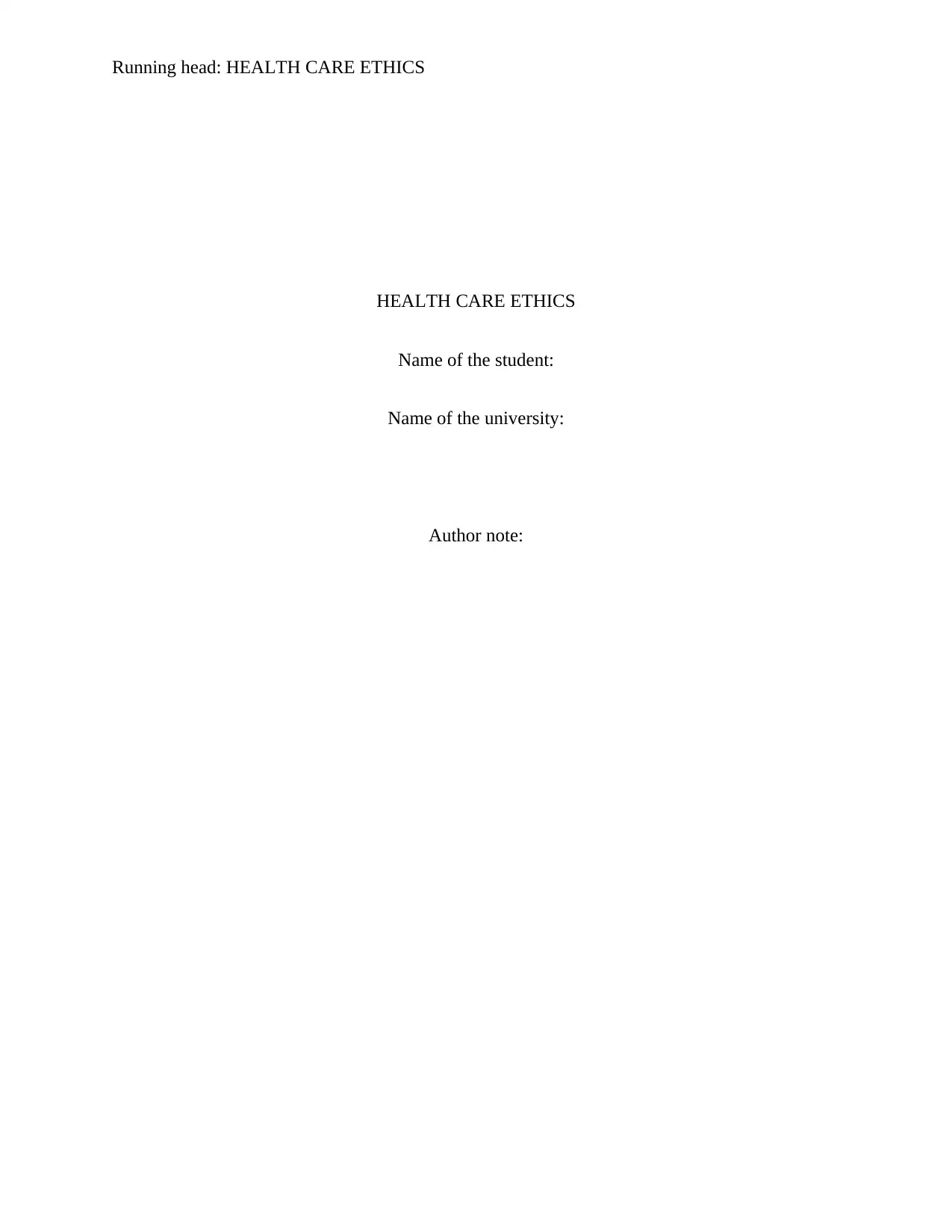
Running head: HEALTH CARE ETHICS
HEALTH CARE ETHICS
Name of the student:
Name of the university:
Author note:
HEALTH CARE ETHICS
Name of the student:
Name of the university:
Author note:
Paraphrase This Document
Need a fresh take? Get an instant paraphrase of this document with our AI Paraphraser
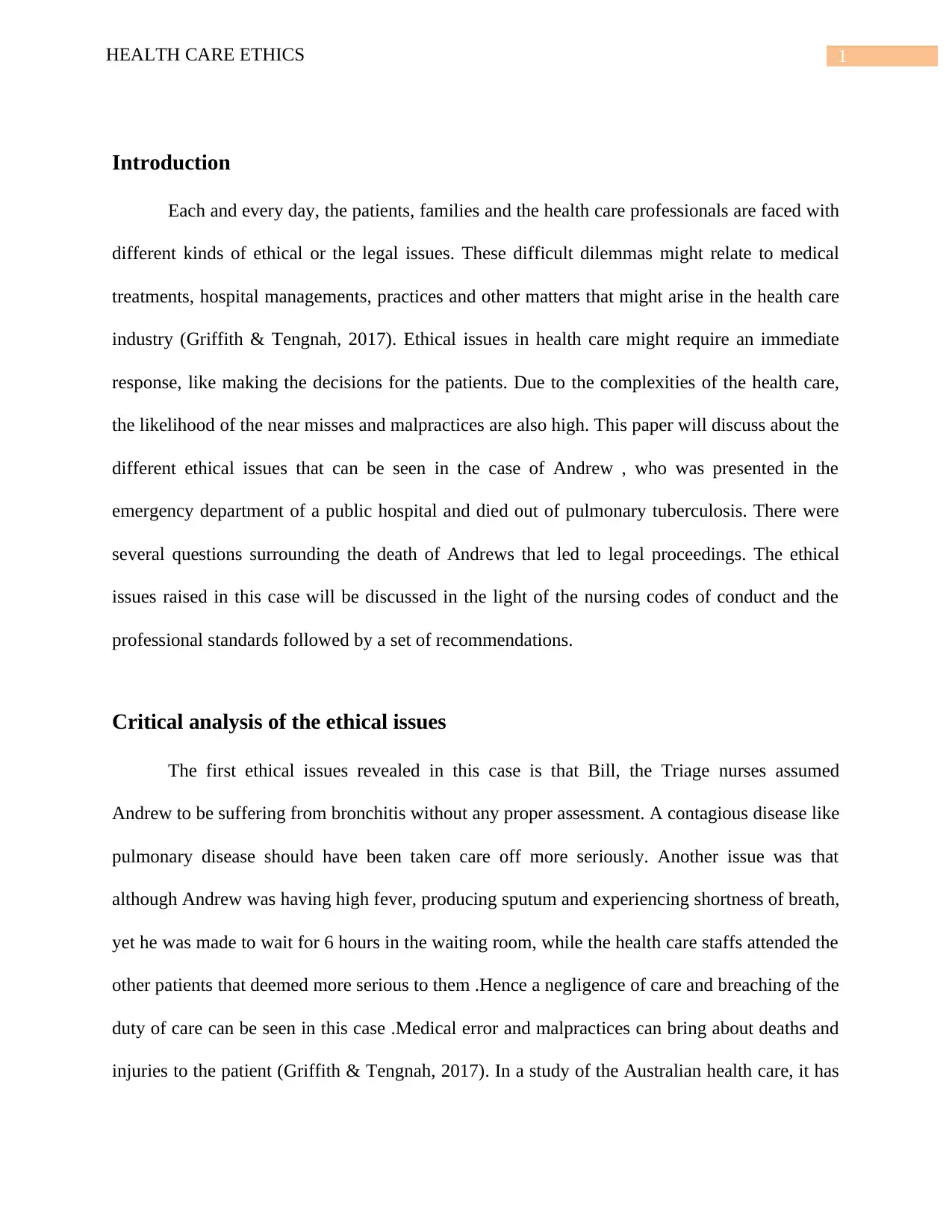
1HEALTH CARE ETHICS
Introduction
Each and every day, the patients, families and the health care professionals are faced with
different kinds of ethical or the legal issues. These difficult dilemmas might relate to medical
treatments, hospital managements, practices and other matters that might arise in the health care
industry (Griffith & Tengnah, 2017). Ethical issues in health care might require an immediate
response, like making the decisions for the patients. Due to the complexities of the health care,
the likelihood of the near misses and malpractices are also high. This paper will discuss about the
different ethical issues that can be seen in the case of Andrew , who was presented in the
emergency department of a public hospital and died out of pulmonary tuberculosis. There were
several questions surrounding the death of Andrews that led to legal proceedings. The ethical
issues raised in this case will be discussed in the light of the nursing codes of conduct and the
professional standards followed by a set of recommendations.
Critical analysis of the ethical issues
The first ethical issues revealed in this case is that Bill, the Triage nurses assumed
Andrew to be suffering from bronchitis without any proper assessment. A contagious disease like
pulmonary disease should have been taken care off more seriously. Another issue was that
although Andrew was having high fever, producing sputum and experiencing shortness of breath,
yet he was made to wait for 6 hours in the waiting room, while the health care staffs attended the
other patients that deemed more serious to them .Hence a negligence of care and breaching of the
duty of care can be seen in this case .Medical error and malpractices can bring about deaths and
injuries to the patient (Griffith & Tengnah, 2017). In a study of the Australian health care, it has
Introduction
Each and every day, the patients, families and the health care professionals are faced with
different kinds of ethical or the legal issues. These difficult dilemmas might relate to medical
treatments, hospital managements, practices and other matters that might arise in the health care
industry (Griffith & Tengnah, 2017). Ethical issues in health care might require an immediate
response, like making the decisions for the patients. Due to the complexities of the health care,
the likelihood of the near misses and malpractices are also high. This paper will discuss about the
different ethical issues that can be seen in the case of Andrew , who was presented in the
emergency department of a public hospital and died out of pulmonary tuberculosis. There were
several questions surrounding the death of Andrews that led to legal proceedings. The ethical
issues raised in this case will be discussed in the light of the nursing codes of conduct and the
professional standards followed by a set of recommendations.
Critical analysis of the ethical issues
The first ethical issues revealed in this case is that Bill, the Triage nurses assumed
Andrew to be suffering from bronchitis without any proper assessment. A contagious disease like
pulmonary disease should have been taken care off more seriously. Another issue was that
although Andrew was having high fever, producing sputum and experiencing shortness of breath,
yet he was made to wait for 6 hours in the waiting room, while the health care staffs attended the
other patients that deemed more serious to them .Hence a negligence of care and breaching of the
duty of care can be seen in this case .Medical error and malpractices can bring about deaths and
injuries to the patient (Griffith & Tengnah, 2017). In a study of the Australian health care, it has

2HEALTH CARE ETHICS
been found that medical negligence had occurred in 12.2% of the admissions, 51 % deaths have
been found to be avoidable (Griffith & Tengnah, 2017). Medical negligence occurs when the
medical practitioner fails provide care that is expected resulting in injury or death of the patient.
It can be any breach of conduct of the health care professionals (Brenner, Brenner, Awerbuch &
Horwitz, 2012). In medical negligence cases it is the duty of the patient to establish that it is the
duty that the concerned nurse or the health care staffs of the hospital owed to the patient. This
can directly bring the concerned health care professionals under the Tort of negligence, where
the claimant (Andrews’s parents) would be able to show a duty of care imposed by the law
(Griffith & Tengnah, 2017).
A nurse is liable to use the ethical frameworks while making the decisions. It can be seen
that Andrew waited in the patient for long 6 hours in the waiting room without care, which is at
the same time both in human and shameful for the nursing profession. A proper RN should be
able to consider and response in a timely manner to the health and wellbeing of the patient. As
per the nursing codes of ethics, an RN should abide by the key ethical principles. Patient should
be shown beneficence by having compassion and taking positive actions to help the others.
Another ethical that can be rightfully placed in the context is the non-maleficence, which enables
the nurses to remain competent in their professions and report any kind of malpractices (Grace,&
DRN, 2017). Patients should be kept first for which nurses might have to push their limits.
According to the Safe patient care Act, a health care organization should have a proper doctor
patient ratio. Lack of staffs and too much patients are likely to cause any kind of medical errors
just as in this case (Ivanov & Oden, 2013).
One of the risk factor for this condition is that during waiting in the waiting room the
bacteria can also get transmitted to other patients waiting in the same waiting room and hence
been found that medical negligence had occurred in 12.2% of the admissions, 51 % deaths have
been found to be avoidable (Griffith & Tengnah, 2017). Medical negligence occurs when the
medical practitioner fails provide care that is expected resulting in injury or death of the patient.
It can be any breach of conduct of the health care professionals (Brenner, Brenner, Awerbuch &
Horwitz, 2012). In medical negligence cases it is the duty of the patient to establish that it is the
duty that the concerned nurse or the health care staffs of the hospital owed to the patient. This
can directly bring the concerned health care professionals under the Tort of negligence, where
the claimant (Andrews’s parents) would be able to show a duty of care imposed by the law
(Griffith & Tengnah, 2017).
A nurse is liable to use the ethical frameworks while making the decisions. It can be seen
that Andrew waited in the patient for long 6 hours in the waiting room without care, which is at
the same time both in human and shameful for the nursing profession. A proper RN should be
able to consider and response in a timely manner to the health and wellbeing of the patient. As
per the nursing codes of ethics, an RN should abide by the key ethical principles. Patient should
be shown beneficence by having compassion and taking positive actions to help the others.
Another ethical that can be rightfully placed in the context is the non-maleficence, which enables
the nurses to remain competent in their professions and report any kind of malpractices (Grace,&
DRN, 2017). Patients should be kept first for which nurses might have to push their limits.
According to the Safe patient care Act, a health care organization should have a proper doctor
patient ratio. Lack of staffs and too much patients are likely to cause any kind of medical errors
just as in this case (Ivanov & Oden, 2013).
One of the risk factor for this condition is that during waiting in the waiting room the
bacteria can also get transmitted to other patients waiting in the same waiting room and hence
⊘ This is a preview!⊘
Do you want full access?
Subscribe today to unlock all pages.

Trusted by 1+ million students worldwide
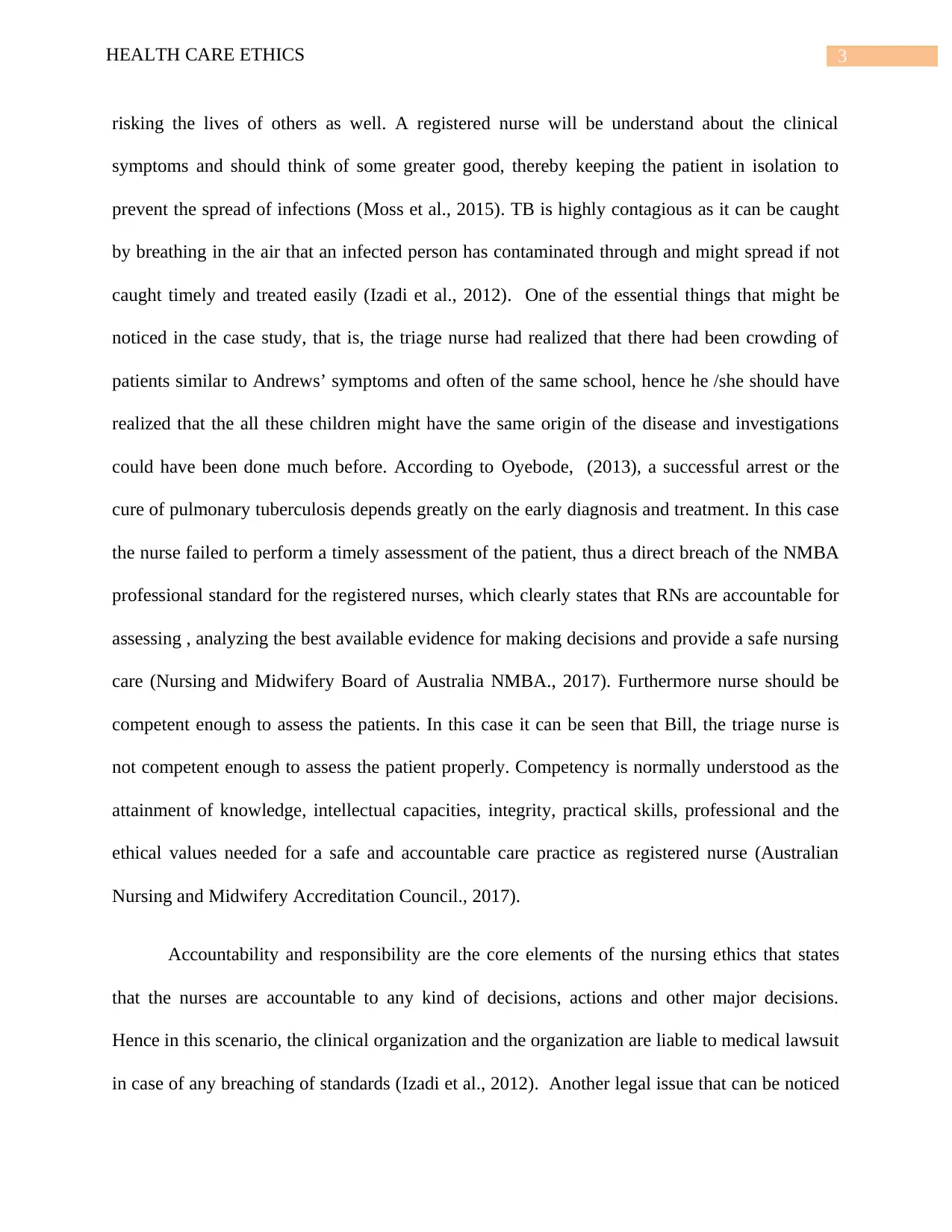
3HEALTH CARE ETHICS
risking the lives of others as well. A registered nurse will be understand about the clinical
symptoms and should think of some greater good, thereby keeping the patient in isolation to
prevent the spread of infections (Moss et al., 2015). TB is highly contagious as it can be caught
by breathing in the air that an infected person has contaminated through and might spread if not
caught timely and treated easily (Izadi et al., 2012). One of the essential things that might be
noticed in the case study, that is, the triage nurse had realized that there had been crowding of
patients similar to Andrews’ symptoms and often of the same school, hence he /she should have
realized that the all these children might have the same origin of the disease and investigations
could have been done much before. According to Oyebode, (2013), a successful arrest or the
cure of pulmonary tuberculosis depends greatly on the early diagnosis and treatment. In this case
the nurse failed to perform a timely assessment of the patient, thus a direct breach of the NMBA
professional standard for the registered nurses, which clearly states that RNs are accountable for
assessing , analyzing the best available evidence for making decisions and provide a safe nursing
care (Nursing and Midwifery Board of Australia NMBA., 2017). Furthermore nurse should be
competent enough to assess the patients. In this case it can be seen that Bill, the triage nurse is
not competent enough to assess the patient properly. Competency is normally understood as the
attainment of knowledge, intellectual capacities, integrity, practical skills, professional and the
ethical values needed for a safe and accountable care practice as registered nurse (Australian
Nursing and Midwifery Accreditation Council., 2017).
Accountability and responsibility are the core elements of the nursing ethics that states
that the nurses are accountable to any kind of decisions, actions and other major decisions.
Hence in this scenario, the clinical organization and the organization are liable to medical lawsuit
in case of any breaching of standards (Izadi et al., 2012). Another legal issue that can be noticed
risking the lives of others as well. A registered nurse will be understand about the clinical
symptoms and should think of some greater good, thereby keeping the patient in isolation to
prevent the spread of infections (Moss et al., 2015). TB is highly contagious as it can be caught
by breathing in the air that an infected person has contaminated through and might spread if not
caught timely and treated easily (Izadi et al., 2012). One of the essential things that might be
noticed in the case study, that is, the triage nurse had realized that there had been crowding of
patients similar to Andrews’ symptoms and often of the same school, hence he /she should have
realized that the all these children might have the same origin of the disease and investigations
could have been done much before. According to Oyebode, (2013), a successful arrest or the
cure of pulmonary tuberculosis depends greatly on the early diagnosis and treatment. In this case
the nurse failed to perform a timely assessment of the patient, thus a direct breach of the NMBA
professional standard for the registered nurses, which clearly states that RNs are accountable for
assessing , analyzing the best available evidence for making decisions and provide a safe nursing
care (Nursing and Midwifery Board of Australia NMBA., 2017). Furthermore nurse should be
competent enough to assess the patients. In this case it can be seen that Bill, the triage nurse is
not competent enough to assess the patient properly. Competency is normally understood as the
attainment of knowledge, intellectual capacities, integrity, practical skills, professional and the
ethical values needed for a safe and accountable care practice as registered nurse (Australian
Nursing and Midwifery Accreditation Council., 2017).
Accountability and responsibility are the core elements of the nursing ethics that states
that the nurses are accountable to any kind of decisions, actions and other major decisions.
Hence in this scenario, the clinical organization and the organization are liable to medical lawsuit
in case of any breaching of standards (Izadi et al., 2012). Another legal issue that can be noticed
Paraphrase This Document
Need a fresh take? Get an instant paraphrase of this document with our AI Paraphraser
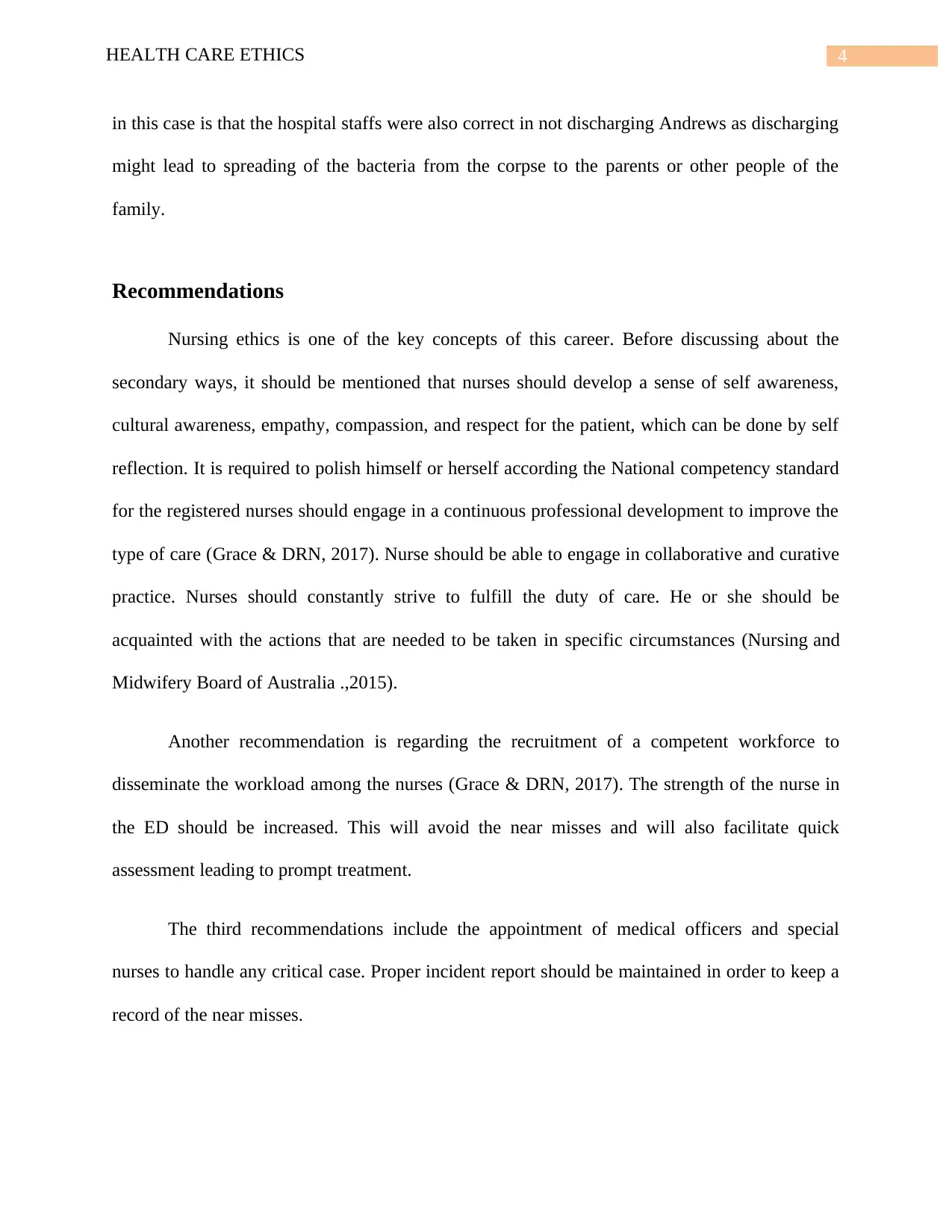
4HEALTH CARE ETHICS
in this case is that the hospital staffs were also correct in not discharging Andrews as discharging
might lead to spreading of the bacteria from the corpse to the parents or other people of the
family.
Recommendations
Nursing ethics is one of the key concepts of this career. Before discussing about the
secondary ways, it should be mentioned that nurses should develop a sense of self awareness,
cultural awareness, empathy, compassion, and respect for the patient, which can be done by self
reflection. It is required to polish himself or herself according the National competency standard
for the registered nurses should engage in a continuous professional development to improve the
type of care (Grace & DRN, 2017). Nurse should be able to engage in collaborative and curative
practice. Nurses should constantly strive to fulfill the duty of care. He or she should be
acquainted with the actions that are needed to be taken in specific circumstances (Nursing and
Midwifery Board of Australia .,2015).
Another recommendation is regarding the recruitment of a competent workforce to
disseminate the workload among the nurses (Grace & DRN, 2017). The strength of the nurse in
the ED should be increased. This will avoid the near misses and will also facilitate quick
assessment leading to prompt treatment.
The third recommendations include the appointment of medical officers and special
nurses to handle any critical case. Proper incident report should be maintained in order to keep a
record of the near misses.
in this case is that the hospital staffs were also correct in not discharging Andrews as discharging
might lead to spreading of the bacteria from the corpse to the parents or other people of the
family.
Recommendations
Nursing ethics is one of the key concepts of this career. Before discussing about the
secondary ways, it should be mentioned that nurses should develop a sense of self awareness,
cultural awareness, empathy, compassion, and respect for the patient, which can be done by self
reflection. It is required to polish himself or herself according the National competency standard
for the registered nurses should engage in a continuous professional development to improve the
type of care (Grace & DRN, 2017). Nurse should be able to engage in collaborative and curative
practice. Nurses should constantly strive to fulfill the duty of care. He or she should be
acquainted with the actions that are needed to be taken in specific circumstances (Nursing and
Midwifery Board of Australia .,2015).
Another recommendation is regarding the recruitment of a competent workforce to
disseminate the workload among the nurses (Grace & DRN, 2017). The strength of the nurse in
the ED should be increased. This will avoid the near misses and will also facilitate quick
assessment leading to prompt treatment.
The third recommendations include the appointment of medical officers and special
nurses to handle any critical case. Proper incident report should be maintained in order to keep a
record of the near misses.
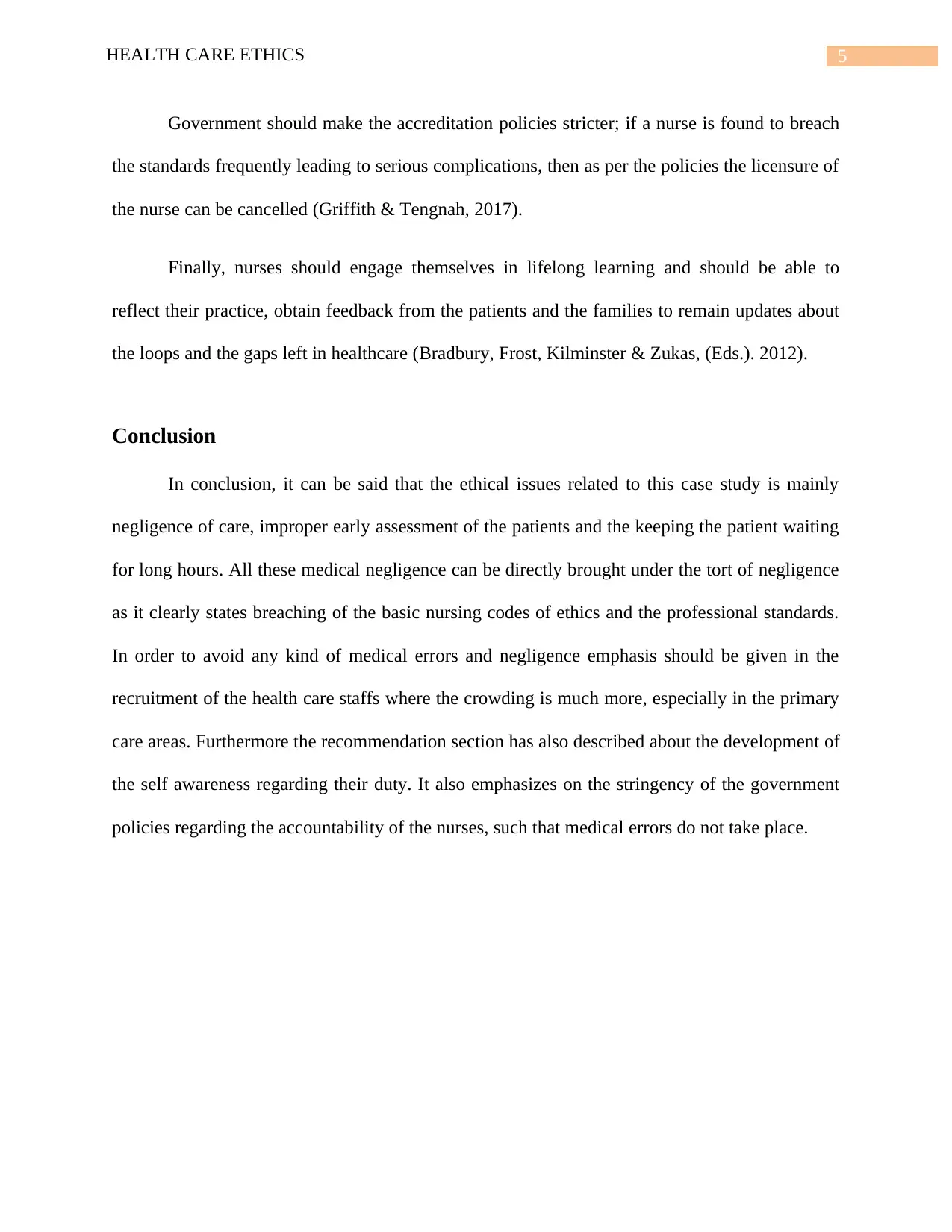
5HEALTH CARE ETHICS
Government should make the accreditation policies stricter; if a nurse is found to breach
the standards frequently leading to serious complications, then as per the policies the licensure of
the nurse can be cancelled (Griffith & Tengnah, 2017).
Finally, nurses should engage themselves in lifelong learning and should be able to
reflect their practice, obtain feedback from the patients and the families to remain updates about
the loops and the gaps left in healthcare (Bradbury, Frost, Kilminster & Zukas, (Eds.). 2012).
Conclusion
In conclusion, it can be said that the ethical issues related to this case study is mainly
negligence of care, improper early assessment of the patients and the keeping the patient waiting
for long hours. All these medical negligence can be directly brought under the tort of negligence
as it clearly states breaching of the basic nursing codes of ethics and the professional standards.
In order to avoid any kind of medical errors and negligence emphasis should be given in the
recruitment of the health care staffs where the crowding is much more, especially in the primary
care areas. Furthermore the recommendation section has also described about the development of
the self awareness regarding their duty. It also emphasizes on the stringency of the government
policies regarding the accountability of the nurses, such that medical errors do not take place.
Government should make the accreditation policies stricter; if a nurse is found to breach
the standards frequently leading to serious complications, then as per the policies the licensure of
the nurse can be cancelled (Griffith & Tengnah, 2017).
Finally, nurses should engage themselves in lifelong learning and should be able to
reflect their practice, obtain feedback from the patients and the families to remain updates about
the loops and the gaps left in healthcare (Bradbury, Frost, Kilminster & Zukas, (Eds.). 2012).
Conclusion
In conclusion, it can be said that the ethical issues related to this case study is mainly
negligence of care, improper early assessment of the patients and the keeping the patient waiting
for long hours. All these medical negligence can be directly brought under the tort of negligence
as it clearly states breaching of the basic nursing codes of ethics and the professional standards.
In order to avoid any kind of medical errors and negligence emphasis should be given in the
recruitment of the health care staffs where the crowding is much more, especially in the primary
care areas. Furthermore the recommendation section has also described about the development of
the self awareness regarding their duty. It also emphasizes on the stringency of the government
policies regarding the accountability of the nurses, such that medical errors do not take place.
⊘ This is a preview!⊘
Do you want full access?
Subscribe today to unlock all pages.

Trusted by 1+ million students worldwide
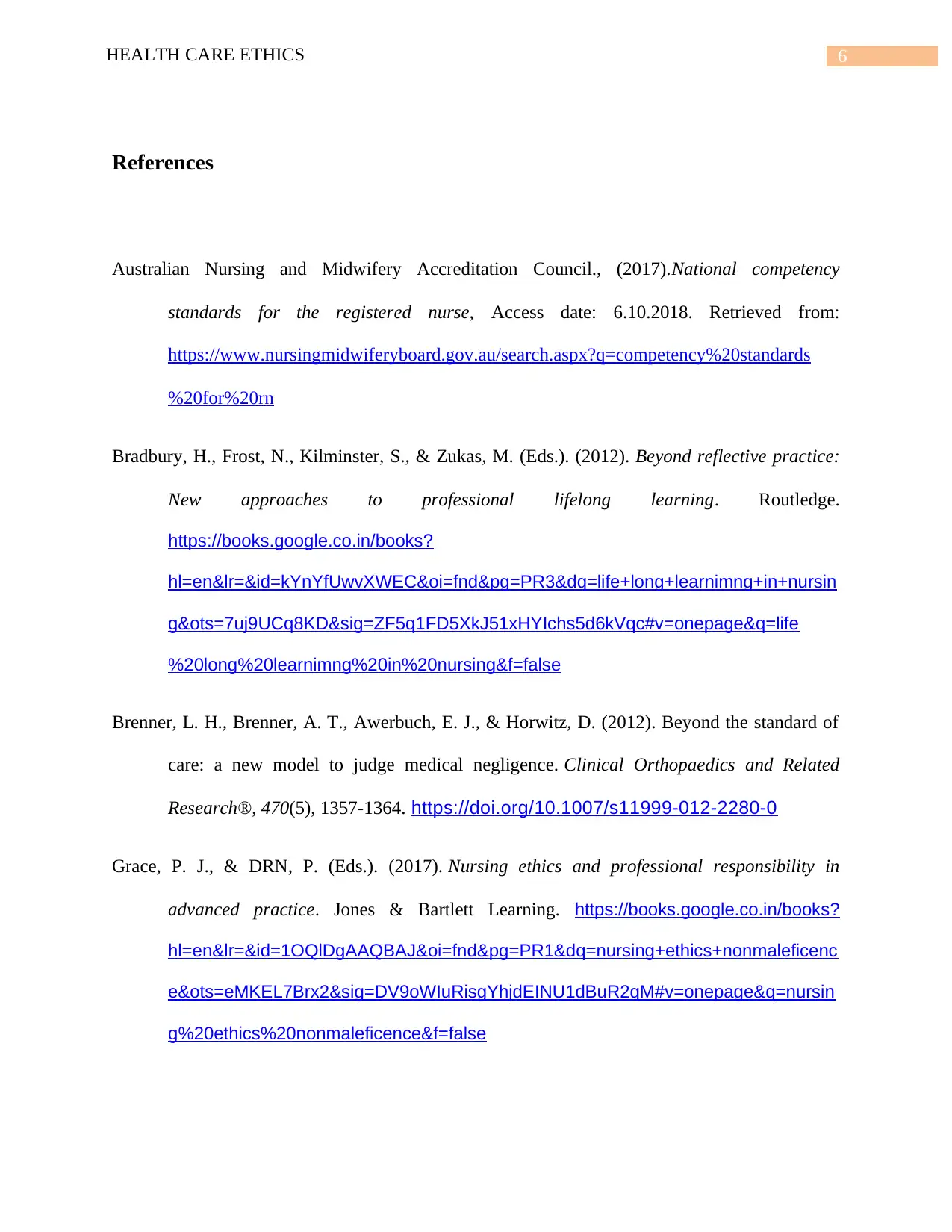
6HEALTH CARE ETHICS
References
Australian Nursing and Midwifery Accreditation Council., (2017).National competency
standards for the registered nurse, Access date: 6.10.2018. Retrieved from:
https://www.nursingmidwiferyboard.gov.au/search.aspx?q=competency%20standards
%20for%20rn
Bradbury, H., Frost, N., Kilminster, S., & Zukas, M. (Eds.). (2012). Beyond reflective practice:
New approaches to professional lifelong learning. Routledge.
https://books.google.co.in/books?
hl=en&lr=&id=kYnYfUwvXWEC&oi=fnd&pg=PR3&dq=life+long+learnimng+in+nursin
g&ots=7uj9UCq8KD&sig=ZF5q1FD5XkJ51xHYIchs5d6kVqc#v=onepage&q=life
%20long%20learnimng%20in%20nursing&f=false
Brenner, L. H., Brenner, A. T., Awerbuch, E. J., & Horwitz, D. (2012). Beyond the standard of
care: a new model to judge medical negligence. Clinical Orthopaedics and Related
Research®, 470(5), 1357-1364. https://doi.org/10.1007/s11999-012-2280-0
Grace, P. J., & DRN, P. (Eds.). (2017). Nursing ethics and professional responsibility in
advanced practice. Jones & Bartlett Learning. https://books.google.co.in/books?
hl=en&lr=&id=1OQlDgAAQBAJ&oi=fnd&pg=PR1&dq=nursing+ethics+nonmaleficenc
e&ots=eMKEL7Brx2&sig=DV9oWIuRisgYhjdEINU1dBuR2qM#v=onepage&q=nursin
g%20ethics%20nonmaleficence&f=false
References
Australian Nursing and Midwifery Accreditation Council., (2017).National competency
standards for the registered nurse, Access date: 6.10.2018. Retrieved from:
https://www.nursingmidwiferyboard.gov.au/search.aspx?q=competency%20standards
%20for%20rn
Bradbury, H., Frost, N., Kilminster, S., & Zukas, M. (Eds.). (2012). Beyond reflective practice:
New approaches to professional lifelong learning. Routledge.
https://books.google.co.in/books?
hl=en&lr=&id=kYnYfUwvXWEC&oi=fnd&pg=PR3&dq=life+long+learnimng+in+nursin
g&ots=7uj9UCq8KD&sig=ZF5q1FD5XkJ51xHYIchs5d6kVqc#v=onepage&q=life
%20long%20learnimng%20in%20nursing&f=false
Brenner, L. H., Brenner, A. T., Awerbuch, E. J., & Horwitz, D. (2012). Beyond the standard of
care: a new model to judge medical negligence. Clinical Orthopaedics and Related
Research®, 470(5), 1357-1364. https://doi.org/10.1007/s11999-012-2280-0
Grace, P. J., & DRN, P. (Eds.). (2017). Nursing ethics and professional responsibility in
advanced practice. Jones & Bartlett Learning. https://books.google.co.in/books?
hl=en&lr=&id=1OQlDgAAQBAJ&oi=fnd&pg=PR1&dq=nursing+ethics+nonmaleficenc
e&ots=eMKEL7Brx2&sig=DV9oWIuRisgYhjdEINU1dBuR2qM#v=onepage&q=nursin
g%20ethics%20nonmaleficence&f=false
Paraphrase This Document
Need a fresh take? Get an instant paraphrase of this document with our AI Paraphraser
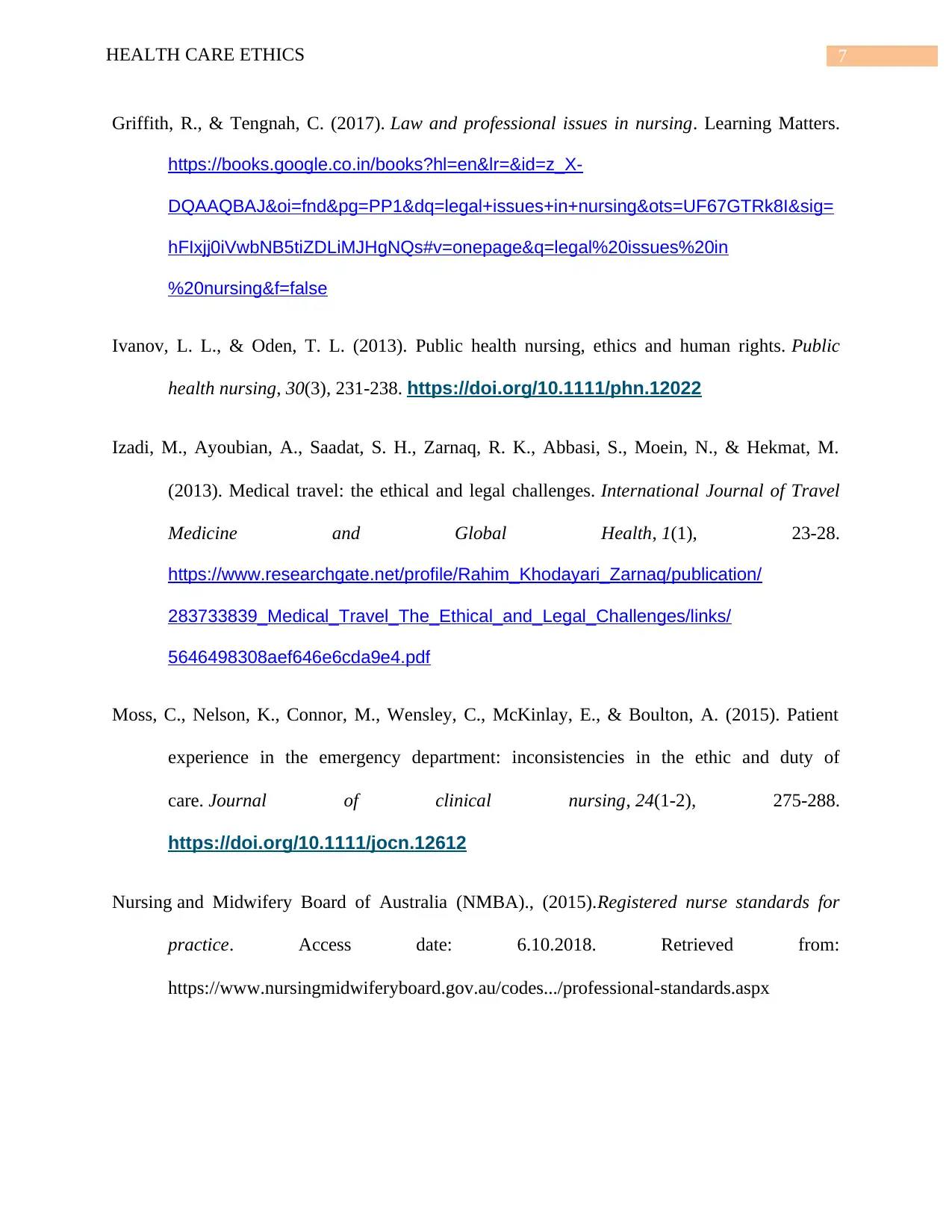
7HEALTH CARE ETHICS
Griffith, R., & Tengnah, C. (2017). Law and professional issues in nursing. Learning Matters.
https://books.google.co.in/books?hl=en&lr=&id=z_X-
DQAAQBAJ&oi=fnd&pg=PP1&dq=legal+issues+in+nursing&ots=UF67GTRk8I&sig=
hFIxjj0iVwbNB5tiZDLiMJHgNQs#v=onepage&q=legal%20issues%20in
%20nursing&f=false
Ivanov, L. L., & Oden, T. L. (2013). Public health nursing, ethics and human rights. Public
health nursing, 30(3), 231-238. https://doi.org/10.1111/phn.12022
Izadi, M., Ayoubian, A., Saadat, S. H., Zarnaq, R. K., Abbasi, S., Moein, N., & Hekmat, M.
(2013). Medical travel: the ethical and legal challenges. International Journal of Travel
Medicine and Global Health, 1(1), 23-28.
https://www.researchgate.net/profile/Rahim_Khodayari_Zarnaq/publication/
283733839_Medical_Travel_The_Ethical_and_Legal_Challenges/links/
5646498308aef646e6cda9e4.pdf
Moss, C., Nelson, K., Connor, M., Wensley, C., McKinlay, E., & Boulton, A. (2015). Patient
experience in the emergency department: inconsistencies in the ethic and duty of
care. Journal of clinical nursing, 24(1-2), 275-288.
https://doi.org/10.1111/jocn.12612
Nursing and Midwifery Board of Australia (NMBA)., (2015).Registered nurse standards for
practice. Access date: 6.10.2018. Retrieved from:
https://www.nursingmidwiferyboard.gov.au/codes.../professional-standards.aspx
Griffith, R., & Tengnah, C. (2017). Law and professional issues in nursing. Learning Matters.
https://books.google.co.in/books?hl=en&lr=&id=z_X-
DQAAQBAJ&oi=fnd&pg=PP1&dq=legal+issues+in+nursing&ots=UF67GTRk8I&sig=
hFIxjj0iVwbNB5tiZDLiMJHgNQs#v=onepage&q=legal%20issues%20in
%20nursing&f=false
Ivanov, L. L., & Oden, T. L. (2013). Public health nursing, ethics and human rights. Public
health nursing, 30(3), 231-238. https://doi.org/10.1111/phn.12022
Izadi, M., Ayoubian, A., Saadat, S. H., Zarnaq, R. K., Abbasi, S., Moein, N., & Hekmat, M.
(2013). Medical travel: the ethical and legal challenges. International Journal of Travel
Medicine and Global Health, 1(1), 23-28.
https://www.researchgate.net/profile/Rahim_Khodayari_Zarnaq/publication/
283733839_Medical_Travel_The_Ethical_and_Legal_Challenges/links/
5646498308aef646e6cda9e4.pdf
Moss, C., Nelson, K., Connor, M., Wensley, C., McKinlay, E., & Boulton, A. (2015). Patient
experience in the emergency department: inconsistencies in the ethic and duty of
care. Journal of clinical nursing, 24(1-2), 275-288.
https://doi.org/10.1111/jocn.12612
Nursing and Midwifery Board of Australia (NMBA)., (2015).Registered nurse standards for
practice. Access date: 6.10.2018. Retrieved from:
https://www.nursingmidwiferyboard.gov.au/codes.../professional-standards.aspx

8HEALTH CARE ETHICS
Oyebode, F. (2013). Clinical errors and medical negligence. Medical Principles and
Practice, 22(4), 323-333..Access date: 6.10.2018. Retrieved from:
https://doi.org/10.1159/000346296
Pegalis, S. E., & Bal, B. S. (2012). Closed medical negligence claims can drive patient safety and
reduce litigation. Clinical Orthopaedics and Related Research®, 470(5), 1398-1404.
https://doi.org/10.1007/s11999-012-2308-5
Rao, S. J. (2012). Medical negligence liability under the consumer protection act: A review of
judicial perspective. Indian journal of urology: IJU: journal of the Urological Society of
India, 25(3), 361. doi: 10.4103/0970-1591.56205
Shin, K. A., & Cho, B. H. (2012). Professional self-concept, critical thinking disposition and
clinical competence in nursing students. Journal of Korean Academy of Fundamentals of
Nursing, 19(1), 46-56. 10.7739/jkafn.2012.19.1.046
Singh, J., & Bhushan, V. (2014). Medical Negligence & Compensation. Bharat Law
Publications.
Sohn, D. H. (2013). Negligence, genuine error, and litigation. International journal of general
medicine, 6, 49. doi: 10.2147/IJGM.S24256
Oyebode, F. (2013). Clinical errors and medical negligence. Medical Principles and
Practice, 22(4), 323-333..Access date: 6.10.2018. Retrieved from:
https://doi.org/10.1159/000346296
Pegalis, S. E., & Bal, B. S. (2012). Closed medical negligence claims can drive patient safety and
reduce litigation. Clinical Orthopaedics and Related Research®, 470(5), 1398-1404.
https://doi.org/10.1007/s11999-012-2308-5
Rao, S. J. (2012). Medical negligence liability under the consumer protection act: A review of
judicial perspective. Indian journal of urology: IJU: journal of the Urological Society of
India, 25(3), 361. doi: 10.4103/0970-1591.56205
Shin, K. A., & Cho, B. H. (2012). Professional self-concept, critical thinking disposition and
clinical competence in nursing students. Journal of Korean Academy of Fundamentals of
Nursing, 19(1), 46-56. 10.7739/jkafn.2012.19.1.046
Singh, J., & Bhushan, V. (2014). Medical Negligence & Compensation. Bharat Law
Publications.
Sohn, D. H. (2013). Negligence, genuine error, and litigation. International journal of general
medicine, 6, 49. doi: 10.2147/IJGM.S24256
⊘ This is a preview!⊘
Do you want full access?
Subscribe today to unlock all pages.

Trusted by 1+ million students worldwide
1 out of 9
Related Documents
Your All-in-One AI-Powered Toolkit for Academic Success.
+13062052269
info@desklib.com
Available 24*7 on WhatsApp / Email
![[object Object]](/_next/static/media/star-bottom.7253800d.svg)
Unlock your academic potential
Copyright © 2020–2025 A2Z Services. All Rights Reserved. Developed and managed by ZUCOL.




